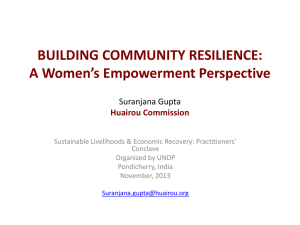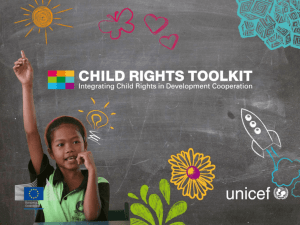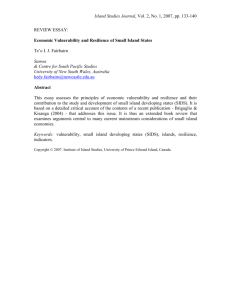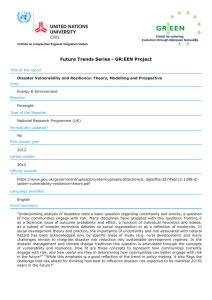RESILIENCE BUILDING AND THE PACIFIC ISLAND COUNTRIES Lino Briguglio University of Malta
advertisement
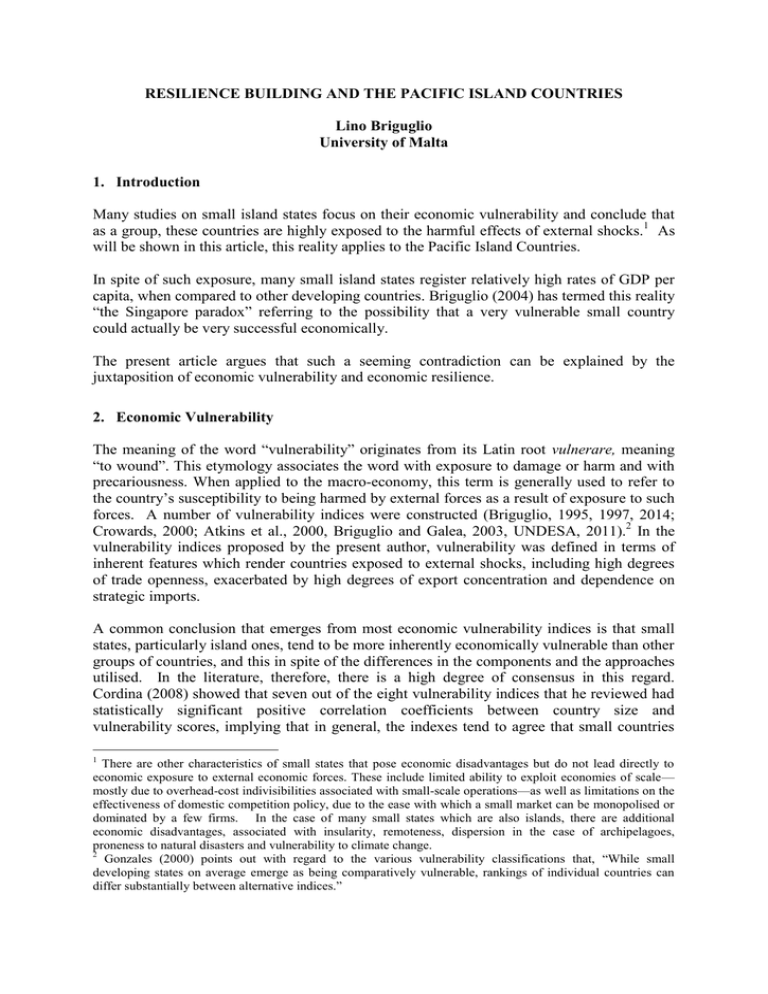
RESILIENCE BUILDING AND THE PACIFIC ISLAND COUNTRIES Lino Briguglio University of Malta 1. Introduction Many studies on small island states focus on their economic vulnerability and conclude that as a group, these countries are highly exposed to the harmful effects of external shocks.1 As will be shown in this article, this reality applies to the Pacific Island Countries. In spite of such exposure, many small island states register relatively high rates of GDP per capita, when compared to other developing countries. Briguglio (2004) has termed this reality “the Singapore paradox” referring to the possibility that a very vulnerable small country could actually be very successful economically. The present article argues that such a seeming contradiction can be explained by the juxtaposition of economic vulnerability and economic resilience. 2. Economic Vulnerability The meaning of the word “vulnerability” originates from its Latin root vulnerare, meaning “to wound”. This etymology associates the word with exposure to damage or harm and with precariousness. When applied to the macro-economy, this term is generally used to refer to the country’s susceptibility to being harmed by external forces as a result of exposure to such forces. A number of vulnerability indices were constructed (Briguglio, 1995, 1997, 2014; Crowards, 2000; Atkins et al., 2000, Briguglio and Galea, 2003, UNDESA, 2011).2 In the vulnerability indices proposed by the present author, vulnerability was defined in terms of inherent features which render countries exposed to external shocks, including high degrees of trade openness, exacerbated by high degrees of export concentration and dependence on strategic imports. A common conclusion that emerges from most economic vulnerability indices is that small states, particularly island ones, tend to be more inherently economically vulnerable than other groups of countries, and this in spite of the differences in the components and the approaches utilised. In the literature, therefore, there is a high degree of consensus in this regard. Cordina (2008) showed that seven out of the eight vulnerability indices that he reviewed had statistically significant positive correlation coefficients between country size and vulnerability scores, implying that in general, the indexes tend to agree that small countries 1 There are other characteristics of small states that pose economic disadvantages but do not lead directly to economic exposure to external economic forces. These include limited ability to exploit economies of scale— mostly due to overhead-cost indivisibilities associated with small-scale operations—as well as limitations on the effectiveness of domestic competition policy, due to the ease with which a small market can be monopolised or dominated by a few firms. In the case of many small states which are also islands, there are additional economic disadvantages, associated with insularity, remoteness, dispersion in the case of archipelagoes, proneness to natural disasters and vulnerability to climate change. 2 Gonzales (2000) points out with regard to the various vulnerability classifications that, “While small developing states on average emerge as being comparatively vulnerable, rankings of individual countries can differ substantially between alternative indices.” are more economically vulnerable than larger ones. 3. Economic Resilience The word “resilience” originates from its Latin roots resilire meaning to rise again. Economic resilience has been defined by Briguglio et al. (2006) as the ability of an economy to withstand or bounce back from the negative effects of external shocks, and the authors associated such ability with policy measures. Guided by this definition, Briguglio et al. constructed a resilience index consisting of four components, namely (a) macroeconomic stability (b) market efficiency (c) social development and (d) good political governance.3 These variables are to a large extent influenced by policy, and are associated with the ability of an economy to absorb or counteract the harmful effects of external shocks. In general the authors found that the 86 countries covered by the index exhibited a wide range of resilience scores, with high-income countries generally ranking higher in this regard than middle- and low-income countries. This tendency was confirmed in Briguglio (2014). 4. Juxtaposing Vulnerability and Resilience According to Briguglio et al. (2006) the juxtaposition of vulnerability and resilience would indicate the overall risk of an economy being harmed by external shocks, as explained in Figure 1. The figure shows that such risk increases with economic vulnerability and decreases with economic resilience. A major implication of the vulnerability/ resilience framework is that small states can succeed economically in spite of their economic vulnerability if they adopt policies conducive to good economic, social and political governance. Figure 1: Risk of being harmed by external economic shocks Risk = Vulnerability (adds to risk) EXPOSURE Risk of being harmed by an external economic shocks Inherent features of a country rendering it exposed to external shocks Inherent Features Trade openness Export Concentration Dependence on strategic imports 3 less Resilience (reduces risk) COPING ABILITY Policy-induced measures that enable a country to withstand external shocks Policy Measures Macroeconomic Stability Market flexibility Social development Good governance Briguglio et al. (2006) also identified environmental management as a possible component of their resilience index, but did not include such a component due to lack of relevant data. An environmental management index was included as a resilience index component in Briguglio (2014). 1 Briguglio et al. (2006), applying this framework and using the vulnerability and resilience indices constructed by the same authors, classified 86 countries into 4 categories, as shown in Figure 2. The results indicated that (a) countries with high resilience and low vulnerability scores are mostly large developed countries with relatively good economic, political and social governance (b) countries with low resilience and vulnerability scores are mostly large developing countries with relatively weak governance (c) countries with high vulnerability and resilience scores are mostly small states with relatively good governance and (d) countries with relatively high vulnerability and relatively low resilience scores include many small states with relatively weak governance. These general tendencies were confirmed in Briguglio (2014), where 183 countries were covered. Vulnerability Index Figure 2: The Vulnerability/Resilience Nexus Resilience Index Given that vulnerability refers to inherent characteristics that render countries prone to external shocks, vulnerability scores for a particular country should not differ much over time, and therefore it is not expected that a country will move vertically along the quadrants of Figure 2, but horizontal movement from the left to the right quadrant is possible for those countries that adopt measures which build resilience. This method of defining vulnerability in terms of inherent features and defining resilience in terms of policy-induced changes has a number of advantages. First, the vulnerability index would refer to permanent (or quasi-permanent) features over which a country can practically exercise no control and therefore cannot be attributed to inadequate policies. In other words, countries scoring highly on the index cannot be accused of self-inflicting vulnerability through misguided policy approaches. Second, the resilience index would refer to what a country can do to mitigate or exacerbate its inherent vulnerability. Third, the combination of the two indices would indicate the overall risk of being harmed by external shocks due to inherent vulnerability features counterbalanced to different extents by policy measures. 2 5. Vulnerability and Resilience of the PICS Briguglio (2014) constructed and computed vulnerability and resilience indices for 183 countries, including nine Pacific Island Countries (PICS),4 basing on the methodology developed in Briguglio et al. (2006). The nine PICS were all found to be highly economically vulnerable (with vulnerability index scores in the top 25% among 183 countries). Samoa topped the list with Vanuatu being a close second. In general PICS tended to have very open economies and were highly dependent on strategic imports, by and large not much different from the average for the rest of the SIDS5 in general. However exports of the PICS were markedly more concentrated than was the case with other SIDS in general. In addition, PICS were highly disaster prone. Their average vulnerability score was about the same as the average for rest of the SIDS, although if one examines individual country scores one finds many exceptions. In general, the vulnerability scores of the PICS was much higher than the average score for non-SIDS, be they high-income, middle-income and low-income countries, indicating that economic vulnerability is highly related to small size and insularity. With regard to the resilience index Briguglio (2014), again using the methodology developed in Briguglio et al. (2006), produced a resilience index which indicated that the resilience rankings of the PICS were not on the high side, due mostly to their relatively low scores relating to political governance, social development and environmental management. Their scores in this regard, where, on average, lower than the average for the rest of the SIDS. The macroeconomic stability scores were, on average, higher than the average for the rest of the SIDS, due to, amongst other things, the PICS’ lower debt ratios. A correlation analysis between the ERI scores and country size indicated that there is no correlation between economic resilience and small size. However there was a positive correlation between income per capita of countries and resilience, suggesting that countries with the best economic performance register the highest resilience scores. It should be noted that these tendencies conceal considerable differences between individual countries in each grouping. Briguglio (2014) classified the nine PICS according to the categories shown in Figure 2, and found that Fiji, Samoa, Tonga and Vanuatu, countries that are highly economically vulnerable, with moderately well governed economies, marginally fit in the north-east quadrant (that is on the far left side of that quadrant). Kiribati, Micronesia, Marshall Islands, Papua New Guinea, and Solomon Islands, which are also highly economically vulnerable, but with weaker resilience scores, fit marginally in the north-west quadrant (that is on the far right side of that quadrant). 6. Implications for the Pacific Island Countries The vulnerability/resilience framework just described has a number of implications for the Pacific Island Countries (PICs) and for small island developing states in general. The 4 These are Fiji, Kiribati, Marshall Islands, Micronesia (Federated States), Papua New Guinea, Samoa, Solomon Islands, Tonga and Vanuatu. There was insufficient data to construct an EVI for the Cook Islands, Nauru, Nuie, Palau and Tuvalu. 5 The comparator SIDS where those on the list of members of AOSIS (http://aosis.org/members/ ), namely Antigua and Barbuda; Bahamas; Barbados; Belize; Cape Verde; Comoros; Dominica; Dominican Republic; Grenada; Guinea-Bissau; Guyana; Haiti; Jamaica; Maldives; Mauritius; Singapore; Seychelles; Sao Tome and Principe; St. Kitts and Nevis; St. Lucia; St. Vincent and the Grenadines; Suriname; Trinidad and Tobago. Cuba and Timor Leste were not included due to insufficient data. 3 framework may be useful to support decision-making in the PICS, especially for setting directions and justifying choice of priorities for resilience building. In particular, the analysis can help to disseminate information on and draw attention to issues relating to resilience building, encourage quantitative estimation of resilience-building and promote the idea of integrated action in this regard. In general, the framework can foster a better understanding of the benefits of good political, economic, social and environmental governance in a country’s pursuit of withstanding external economic shocks. The vulnerability/resilience framework developed by Briguglio et al. (2006) has inspired various studies and applied work on the subject. 6 A major policy implication for the PICS associated with this framework is that in view of their high degree of economic vulnerability, resilience building is of major importance for these states and it therefore follows that it pays these states to embed resilience building measures in their plans. The framework has additional implications regarding the attraction of investment in small states, given that everything else remaining equal, in a country that is well-governed economically and enjoying political and social stability, domestic and foreign investments are more likely to be attracted, when compared to a badly governed and socially unstable country. Small states tend to be disadvantaged with regard to investment attraction due to their small domestic markets and poor natural resources endowments however good economic governance could to an extent make up for these inherent deficiencies. A further implication of relevance to PICS relate to regional collaboration. Due mostly to the problem of indivisibility of certain overhead costs, certain regulatory frameworks required for good economic governance may be prohibitively expensive for a single small state on its own, but affordable regionally. For this reason PICS could benefit through further regional cooperation by jointly undertaking policy-measures conducive to resilience building. Such cooperation could, for example, be successfully undertaken in putting in place competition law and policy, telecommunications regulations, air and shipping services, and pooling of expertise for various purposes, including for international negotiations. An important consideration, with regard to the high vulnerability scores of the PICS, is that economic vulnerability is not often given due importance in development assistance, especially when these states are classified as middle-income countries, even though such vulnerability poses serious disadvantages on these states. It would therefore be beneficial for vulnerable SIDS if donor countries and organisations devise development support schemes 6 The vulnerability/resilience framework proposed in Briguglio et al. (2006) generated considerable interest among international organisations working in the interests of small states. This framework was used by the Commonwealth Secretariat to conduct vulnerability/resilience profiles in three small island states, namely Seychelles, St Lucia and Vanuatu, as explained in the book by Briguglio et al. (2010). The V&R framework was also referred to in the report of the UN Secretary-General (available at: http://www.un.org/ga/search/view_doc.asp?symbol=A/65/115) on the occasion of the five-year review of the Mauritius Strategy for the Further Implementation of the Programme of Action for the Sustainable Development of SIDS. ESCAP et al. (2010) sought to assess the impact of the global financial crisis by developing a vulnerability index. In their report (Appendix 3) ESCAP et al. acknowledge that their approach was inspired by the work of Briguglio et al. (2006). UNDESA, in preparation for the Third International Conference on SIDS in Samoa in 2014, has also embarked on developing a vulnerability-resilience framework by building on the approach pioneered by Briguglio et al. (information available at: http://www.sids2014.org/content/documents/260attrdlu7.pdf). 4 which effectively7 factor in a vulnerability criterion. Such a criterion would be especially relevant when the support in intended to strengthen the economic resilience of the PICS. 7. CONCLUSION The main message of this article is that the fact that small states tend to be economically vulnerable should not be construed as an argument for complacency on the part of these states. There are a number of resilience-building policy options which could enable these states to minimise or withstand the negative effects of external economic shocks. This, in turn, entails that small states should assign major importance to resilience-building policies, and possibly embed such policies into their national plans and strategies. This message is also relevant for the donor community in their quest to support the economic development of small states. Given that these states tend to be highly economically vulnerable, ODA and other forms of aid should include resilience-building as an important motive of such support. REFERENCES Briguglio, L. (1995). Small island states and their economic vulnerabilities. World Development, 23, 1615-1632. Briguglio, L. (1997). Alternative economic vulnerability indices for developing countries. Report prepared for the United Nations Department of Economic and Social Affairs. Briguglio, L. (2004). Economic Vulnerability and Resilience: Concepts and Measurements. In Briguglio, L. and Kisanga, E.J. (eds), Vulnerability and Resilience of Small States. Commonwealth Secretariat and the University of Malta, 43-53. Briguglio (2014). A vulnerability and resilience framework for small states. Report prepared for the Commonwealth Secretariat Briguglio, L., & Galea, W. (2003). Updating and augmenting the economic vulnerability index. Occasional Reports on Islands and Small States, No. 2004/4. Malta: Islands and Small States Institute of the University of Malta. Briguglio, L., Cordina, G., Farrugia, N., & Vella, S. (2006). Conceptualising and measuring economic resilience. In L. Briguglio, G. Cordina, and E. Kisanga, E. (Eds.), Building the Economic Resilience of Small States (pp. 265-288). Malta: Islands and Small States Institute in collaboration with the Commonwealth Secretariat. Briguglio, L., Cordina, G., Vella, S., & Vigilance, C. (2010). Profiling vulnerability and resilience: A manual for small states. Commonwealth Secretariat and Islands and Small States Institute of the University of Malta. Cordina, G. (2008). The macroeconomic and growth dynamics of small states. In Small States: Economic Review & Basic Statistics (pp. 21-37). London: Commonwealth Secretariat. Crowards, T. (2000a). An index of economic vulnerability for developing countries. Barbados: Caribbean Development Bank. 7 The word “effectively” should be emphasized in this context because even in the case of LDC graduation, where a vulnerability index is used as a criterion, its effect is negligible. On this issue see statement by the Government of the Maldives available at: http://www.maldivespartnershipforum.gov.mv/pdf/Impacts%20of%20LDC%20Graduation.pdf and also statement by the representative of Samoa available at: http://www.un.int/wcm/webdav/site/samoa/shared/documents/United%20Nations%20High%20Level%20Meeti ng%20to%20Review%20the%20Brussels%20Program%20of%20Action.doc. 5 ESCAP, ADB, & UNDP (2010). Achieving the Millennium Development Goals in an era of global uncertainty - Asia-Pacific Regional Report 2009/10. Retrieved from http://content.undp.org/go/cms-service/stream/asset/?asset_id=2269033 . Gonzalez, A., (2000). Policy implications of smallness as a factor in the Lome, FTAA and WTO Negotiations. Final Report, 7/9/00. UNDESA (2011). LDC information: The criteria for identifying Least Developed Countries. Retrieved from http://www.un.org/en/development/desa/policy/cdp/ldc/ldc_criteria.shtml#evi . 6
